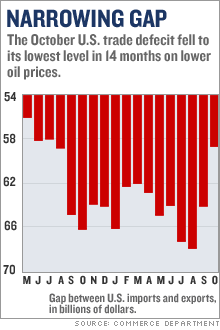Trade gap sinks to 14-month lowDeficit posts surprise drop to lowest since August 2005 on falling oil prices; China gap rises as Paulson, Bernanke head there for talks.NEW YORK (CNNMoney.com) -- The nation's trade deficit tumbled in October on lower prices for oil imports, but the gap with China kept growing ahead of a key trip to that country by Treasury Secretary Henry Paulson, Federal Reserve Chairman Ben Bernanke and other top officials. Overall, imports topped exports by $58.9 billion in October, down from $64.3 billion in September, the Commerce Department reported. Economists surveyed by Briefing.com had forecast a much smaller decline, to $63 billion.
But the deficit widened with China, which runs by far the biggest trade surplus with the United States of any other country. The report comes as Paulson, U.S. Trade Representative Susan Schwab and other officials left for China for meetings that are sure to bring up some contentious trade issues. Bernanke is due to join them after Tuesday's meeting of the Fed policymakers. The report comes a day after Schwab criticized China's trading practices in a report to Congress, and Paulson criticized China in an opinion column published in the Washington Post. "The United States and China have both benefited greatly from our growing trade relationship," Schwab wrote in a report issued Monday to Congress on trade with China. "At the same time, certain industries face frustrating barriers to doing business in China, and there are worrisome signs that China's market liberalization efforts have slowed in the last year." China's trade surplus with the U.S. jumped to $24.4 billion in October from just under $23 billion in September. The year-to-date gap with China now stands at $190.6 billion, up 14 percent from the same period last year. No other trading partner has a trade surplus even a third of U.S.-China gap. Paulson's Post column said that China needed to do more to let its currency, the yuan, be set by markets. An undervalued yuan, which is essentially pegged to the dollar, is blamed by many economists for the larger trade imbalance because it makes Chinese goods less expensive in the United States and U.S. exports more expensive there. Paulson also said that China needed to do more to protect intellectual property rights. "One of the most important topics for discussion is how to help China manage its transition to freer, more open markets, including capital markets," wrote Paulson, who is a former CEO of investment bank Goldman Sachs (Charts). "Every strong, vibrant economy in the world has open, competitive capital markets that attract investment and allocate resources to their most productive uses....Strengthening and reforming financial markets will ultimately allow the Chinese to freely float their currency." China has become the United States' No. 3 trading partner, behind only the European Union and Canada, and even with the trade gap, the No. 5 market for U.S. goods exports. Critics of U.S. trade policy with China said the Bush administration needs to do more than it has the last six years to improve U.S. competitiveness with China, especially the value of the yuan. "Diplomatic efforts to persuade China to stop manipulating currency markets have so far failed," University of Maryland economics professor Peter Morici wrote Tuesday. "Should (Paulson and Bernanke) return empty handed or with only symbolic gestures from Beijing, the United States will be left to either impose tariffs or accept the consequences of large and widening trade deficits for U.S. growth and living standards." Oil decline helps trim gap Even with the continued growth in the gap with China, October saw the smallest gap since August 2005, mainly due to an 11.3 percent drop in the average price of oil imports. The volume of oil imports also fell, so the gap attributed to petroleum products sank $3.9 billion, or 17 percent, while the portion of the gap attributed to non-petroleum goods narrowed just $1.4 billion, or 2 percent. Exports overall edged up just 0.2 percent from September, to $123.6 billion, but that was enough to again set a record. Total imports fell nearly 3 percent to $182.5 billion. Jay Bryson, international economist for Wachovia, said that with the improved outlook for U.S. exports, the trade gap could be leveling off and could see some improvement going into 2007. "The real trade deficit (i.e., the deficit measured in volume terms) has been essentially unchanged on balance over the past year or so, which should lead to stability in the nominal trade deficit as well," he wrote in a note after the Tuesday report. "U.S. real GDP growth has slowed over the past few quarters, which should lead to slower growth in imports. On the other hand, economic growth in the rest of the world remains fairly strong, which has helped to push up export growth. Indeed, U.S. export volumes are currently growing at the strongest rate since early 2000." But he said that the improvement will be modest compared to the current size of the deficit unless the U.S. falls into recession in 2007, which he and other Wachovia economists do not forecast. The smaller trade gap helped lift the dollar off earlier losses against the euro and the yen, leaving the greenback essentially unchanged from Monday's close in late morning trading, ahead of the Fed announcement. |
|


